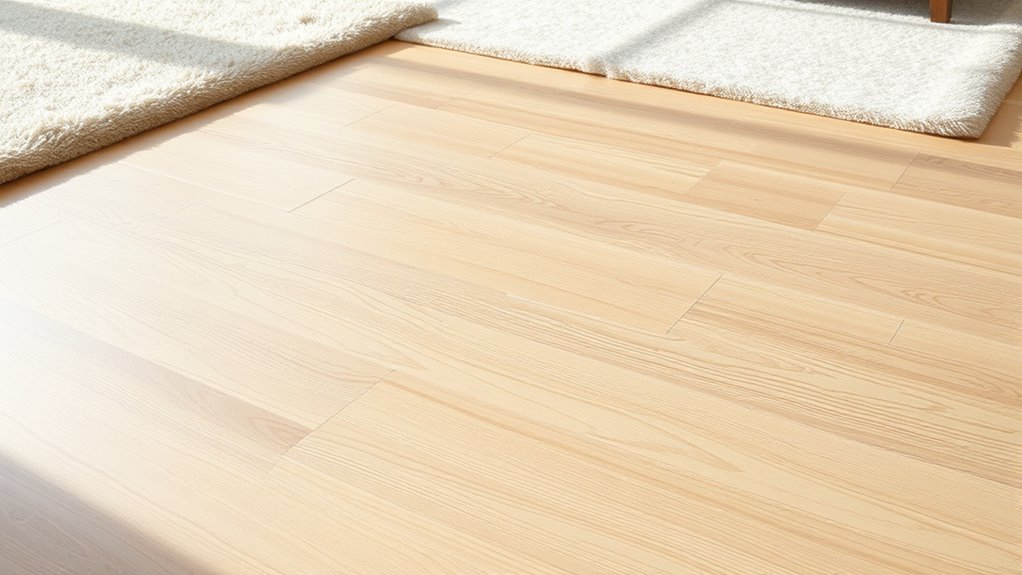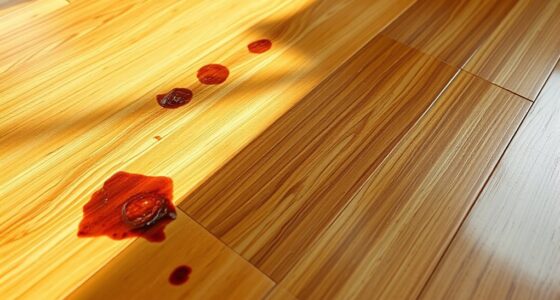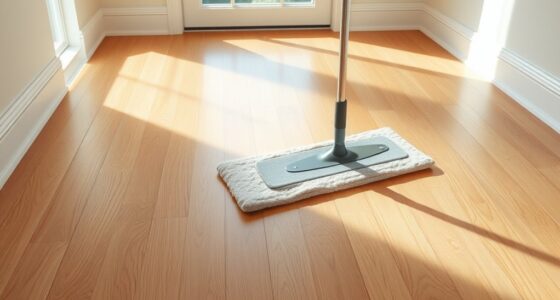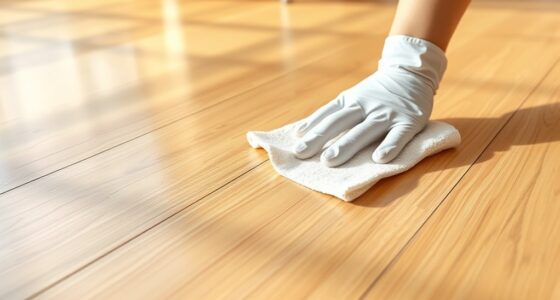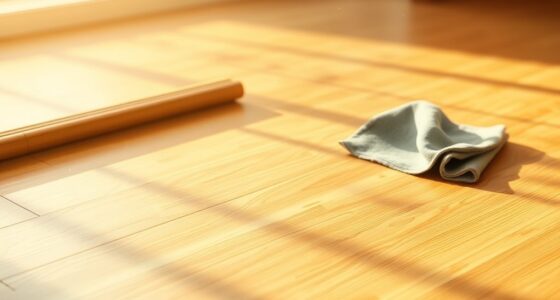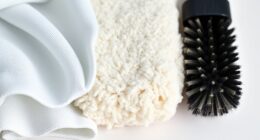To keep your engineered wood looking its best, spend just 15 minutes a day dusting with a damp cloth or gentle cleaner. Avoid excess water to prevent damage, and wipe up spills immediately. Regular light cleaning helps maintain its durability, preserves the natural appearance, and extends its lifespan. With quick daily attention, your floors or furniture stay beautiful and durable—if you’re ready to learn more about the best care techniques, keep exploring.
Key Takeaways
- Use a damp cloth or gentle cleaner to quickly wipe dust and spills on engineered wood surfaces.
- Avoid excessive water to prevent damage to the layered core and veneer.
- Regularly sweep or vacuum to remove debris that can scratch or wear the surface.
- Clean spills immediately to prevent stains and moisture absorption.
- Incorporate a quick, weekly polish or protective spray to maintain shine and durability.
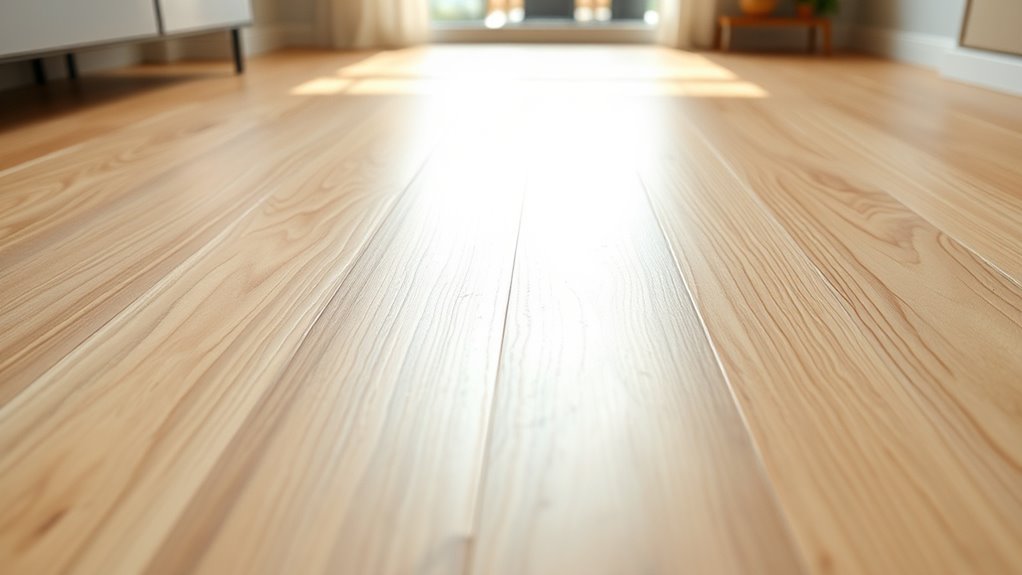
Have you ever wondered how modern construction and furniture manufacturing achieve strength and durability with less waste? It’s all about innovative materials like engineered wood, which combines the best of natural wood and clever engineering. When you consider laminate flooring, you’re looking at a prime example of engineered wood’s utility. Laminate flooring features a core made from high-density fiberboard or particleboard, topped with a photographic layer that mimics wood grain, and sealed with a clear protective layer. This setup not only looks authentic but also offers resistance to scratches, moisture, and wear. It’s a smart choice if you want the beauty of wood without the high maintenance or susceptibility to damage that solid wood often requires.
Similarly, wood veneer is a key element in engineered wood products. Wood veneer involves thin slices of real wood glued onto a core material, creating a surface that looks like solid wood but uses less raw material. This means you get the rich, natural appearance of hardwood with markedly less waste. The core beneath the veneer can be made from recycled wood fibers or other engineered materials, making the entire process more sustainable. The combination of veneer and core material allows manufacturers to produce furniture and flooring that are both aesthetically pleasing and environmentally friendly. You get the warmth and character of real wood without depleting forests at the same rate.
Engineered wood’s design means it’s easier to produce, transport, and install. It’s less prone to warping or splitting because the layers are bonded under controlled conditions, making it a more stable option than solid wood. For you, this translates into flooring and furniture that last longer and maintain their appearance with minimal fuss. When cleaning, a quick 15-minute routine is enough to keep your engineered wood surfaces looking their best. Use a damp cloth or a gentle cleaner to wipe away dust and spills, avoiding excess water that could damage the layers. Regular maintenance not only preserves the beauty but also extends the lifespan of your investment. Incorporating proper storage techniques can further prolong the life of engineered wood products by preventing moisture and temperature fluctuations from affecting the layers.
Engineered wood also lends itself well to various finishes and styles, from sleek modern looks to rustic charm. Its versatility means you can choose laminate flooring for a durable, budget-friendly option or opt for wood veneer surfaces that add a touch of luxury. Both are crafted with sustainability in mind, reducing waste during production and conserving natural resources. So, whether you’re updating your floors or furniture, engineered wood offers a practical, eco-conscious solution that combines strength, beauty, and ease of maintenance—all achievable with just a quick daily clean.
Frequently Asked Questions
Can Engineered Wood Be Cleaned With Harsh Chemicals?
You shouldn’t use harsh chemicals on engineered wood, as they can cause surface damage and affect chemical safety. Stick to gentle cleaners like a damp cloth or a mild wood floor cleaner. Avoid abrasive or toxic substances that could ruin the finish or harm your health. Regular, soft cleaning preserves your floor’s look and keeps it safe for everyone in your home.
How Often Should I Deep Clean Engineered Wood Flooring?
Have you ever wondered how often you should deep clean your engineered wood flooring? Typically, you should follow a maintenance schedule of every 6 to 12 months, depending on foot traffic and wear. Regular cleaning frequency keeps your floors looking their best, prevents buildup, and extends their lifespan. Think about your daily routine—does it align with this schedule? Proper care now saves you time and money later.
Is Vinegar Safe for Cleaning Engineered Wood Surfaces?
Vinegar safety for cleaning engineered wood is limited; it’s acidic and can damage the surface over time. For deep cleaning or stain removal, avoid harsh chemicals and steer clear of steam mops, which can cause warping. Instead, use a damp cloth with a mild, pH-neutral cleaner. Vinegar isn’t the best option for engineered wood, as it may harm the finish, so opt for safer alternatives to keep your floors looking great.
What Is the Best Way to Remove Stains From Engineered Wood?
To remove stains from engineered wood, you need effective stain removal techniques and the right cleaning product recommendations. Start by gently blotting the stain, avoiding rubbing, then apply a mixture of mild dish soap and water or a specialized wood cleaner. For stubborn stains, use a soft cloth dampened with vinegar diluted in water. Always test in an inconspicuous spot to prevent damage, and follow up with a dry cloth.
Can I Use a Steam Mop on Engineered Wood Floors?
You can use a steam mop on engineered wood floors, but do so cautiously. Steam cleaning can be effective because it removes dirt without harsh chemicals and helps maintain chemical resistance. However, verify the steam mop’s settings are gentle, and avoid excessive moisture, which can damage the wood. Always check your manufacturer’s guidelines first to prevent warping or peeling, and use a microfiber pad for best results.
Conclusion
With just 15 minutes a day, you can keep your engineered wood looking pristine. Think of it as a small investment that pays off in lasting beauty and durability. Remember, neglect is the thief of shine—don’t let dirt and dust steal your floor’s charm. By sticking to this simple routine, you’ll preserve its elegance and strength, proving that consistency truly is the secret to timeless appeal. Your engineered wood deserves this daily act of care.
